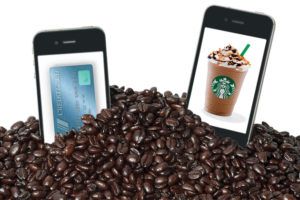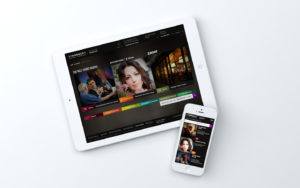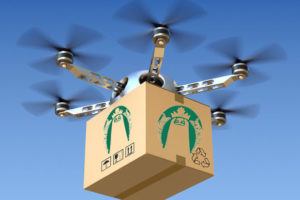Starbucks: A Technology Pioneer

Since 1971, Starbucks has been serving customers high-quality coffee with personalized service offered in an upscale yet inviting store atmosphere. During that time, the company has adjusted to changes in consumer lifestyles and behavior by offering single-serve coffee for home or office use, drive-through windows for convenience, and offering food items to complement its beverages. In the past decade, Starbucks has invested heavily in technology to enhance operations and improve the customer’s experience. Below are three noteworthy examples:
Mobile Order & Pay and Digital Loyalty Program
In December 2014, Starbucks released its Mobile Order & Pay, a smartphone-based application that enabled customers to do two things: (1) submit an order in advance via the app, and (2) pay using the app when picking up the order at the store.1 According to the company’s September 27, 2016 fiscal year-end filing, 25% of all sales were completed using Mobile Pay, up 20% from the previous year.2 Despite not being offered in all stores yet, Mobile Order accounted for 6% of fourth quarter sales, up from 5% in the preceding quarter.3 Operationally, Mobile Order & Pay is helping Starbucks accomplish the following three things:
- Reduce the bottleneck—taking orders and processing payments
- Smooth demand and increase employee utilization
- Decrease customer wait times
Mobile Order & Pay was an evolution of Starbucks’ existing app, initially developed to migrate customers from its card-based loyalty program to a digital version. In addition to being the platform for Mobile Order & Pay, the digital loyalty program has enabled Starbucks to engage more directly with customers, for example, offering birthday rewards or promotional pricing during inclement weather or slower mid-day periods. Starbucks customers also earn loyalty “stars” when using services from technology-drive companies with which Starbucks has partnered, like Lyft and Spotify.4
My Starbucks Idea and Starbucks Digital Network
In 2008, Starbucks launched its My Starbucks Idea initiative. The purpose of the initiative was to open communication with customers willing to share their ideas of what would make Starbucks better. Many of Starbucks’ technological initiatives came from via this simple platform, for example, Mobile Pay and in-store WiFi.5 In the latter case, Starbucks not only rolled-out free WiFi across its stores, it partnered with Yahoo! and other content providers to develop the Starbucks Digital Network, offering premium digital content like the New York Times, Economist, and Wall Street Journal to in-store customers. In July 2015, the company announced a partnership with The New York Times to offer content to members of its loyalty program via the Starbucks app.6
Green Apron and Drone Delivery
Seeing success with its Mobile Order & Pay, a natural extension is to use technology to improve the delivery of products. In October 2015, Starbucks rolled out its Green Apron service which offered delivery service to customers using Mobile Order & Pay. Requested by customers and designed specifically for dense urban environments, Green Apron service was first launched in the Empire State Building in downtown Manhattan.7 Following early success in New York, the company partnered with Postmates, a technology-driven food delivery platform, to deliver orders to nearby customers in other metropolitan areas.8
To expand its delivery offering, Starbucks partnered with Google X, an Alphabet subsidiary, to test delivery via drone. The companies had tested deliveries and were in advanced partnership talks when Alphabet pulled the plug on the Google X project due to disagreements over access to customer data and as part of a broader Alphabet effort to rein in spending and focus on turning other experimental projects into real businesses.9
While it has benefited from early technology investments, Starbucks should not let up. In addition to investing in order and delivery capabilities, the company should leverage technology to improve its operations and drink-making technology. For example, Starbucks could invest in inventory management systems to track expiration and replenishment of ingredients, ingredient dispensing controls to automate ingredient add-ins currently being done manually and reduce waste, and temperature controls to offer customization if desired or simply improve temperature consistency. The company could also consider launching a My Starbucks Idea campaign to generate ideas from customers as to how to better leverage technology give that they use and observe the company’s products so frequently.
As long as management continues to prioritize technology, Starbucks’ customers, employees, and shareholders should benefit. According to Starbuck’s CEO, Howard Schultz, that seems to be the focus:
By anticipating and beginning to invest many years ahead of the mobile technology curve, Starbucks today is defining customer-facing … mobile and retail experiences of the future. And the technology innovations we are introducing are further strengthening our brand, improving our efficiency and in-store execution, increasing our profitability, enabling us to further extend our lead over competitors, and, most importantly, enabling us to deliver an elevated Starbucks experience to our customers.10
Word Count – 798
Sources:
[1] “Starbucks Mobile Order & Pay Expansion,” Starbucks News Release, June 16, 2015, https://news.starbucks.com/news/starbucks-mobile-order-and-pay-expansion.
[2] “Starbucks’ Earnings: Here’s the Most Interesting Number,” Barron’s, November 3, 2016, http://www.barrons.com/articles/starbucks-earnings-heres-the-most-interesting-number-1478209336.
[3] “Here’s How Mobile Order & Pay Could Lift Starbucks,” The Business Insider, November 7, 2016, http://www.businessinsider.com/heres-how-mobile-order-and-pay-could-lift-starbucks-2016-11.
[4] “How Starbucks is Using Technology to Boost Revenue,”, Marketing Week, October 30, 2015, https://www.marketingweek.com/2015/10/30/how-starbucks-is-using-technology-to-boost-revenue/.
[5] “Starbucks Celebrates Five-Year Anniversary of My Starbucks Idea,” Business Wire, March 29, 2013, http://www.businesswire.com/news/home/20130328006372/en/Starbucks-Celebrates-Five-Year-Anniversary-Starbucks-Idea.
[6] “Some New York Times Articles to Appear Free on Starbucks App,” The New York Times, July 21, 2015, http://www.nytimes.com/2015/07/22/business/media/some-new-york-times-articles-to-appear-free-on-starbucks-app.html.
[7] “Starbucks Green Apron Delivery Service Begins in the Empire State Building,” Starbucks News Release, October 13, 2015, https://news.starbucks.com/news/starbucks-green-apron-delivery-empire-state-building.
[8] “Starbucks Delivery by Postmate Begins Service in Seattle,” Starbucks News Release, December 2, 2015, https://news.starbucks.com/news/starbucks-postmates-in-seattle.
[9] “Alphabet Taps Brakes on Drone Project, Nixing Starbucks Partnership,” Bloomberg, November 8, 2016, https://www.bloomberg.com/news/articles/2016-11-08/alphabet-taps-brakes-on-drone-project-nixing-starbucks-partnership.
[10] “Starbuck’s Digital Transformation: The Takeaways Every Enterprise Needs to Know,” ZDNet, November 1, 2015, http://www.zdnet.com/article/starbucks-digital-transformation-the-takeaways-every-enterprise-needs-to-know/.






Hi SBUX – appreciate your post! Def agree that mobile ordering creates better operational efficiency. Though you argue that going mobile and adding delivery services (either via postdate or drones) could elevate the customer experience, I wonder if it really would if these customers visit the retail stores less. So much of the SBUX experience is about the atmosphere in the physical store from a smile to friendly attitude to chic furniture/decor. Do you think going digital complement or replace the traditional experience?
In addition, given that we just did the climate change challenge, what do you think of the delivery initiative in relation to SBUX’s commitment in sustainability. Delivery will likely increase SBUX’s carbon footprint. Should SBUX still offer this service at the expense of the environment?
I’m interested in how payment is moving digitally for players like Starbucks, and what that might mean for existing payments systems. Starbucks also has its stored-value rewards cards (which I believe they incent via “buy x drinks, get one free”), which have moved on to their mobile payments & ordering app.
If they are able to get customers to pay via their shared value cards, Starbucks can avoid paying the ~$.30 + ~2-3% charged by VISA or Amex, per transaction. These fees end up being pretty substantial, especially when you consider a person buying a single cup of coffee for ~$2-3. I wonder if these stored-value cards will increase in use via mobile payment applications for Starbucks and other retailers – and if you were VISA, how would you respond?
Thanks for a really interesting article!
Firstly to Mary’s point above – I don’t think that the delivery system is intended to replace the traditional ‘third place’ experience of Starbucks. Specifically, the relatively high $5.99 delivery fee means that your average customer is unlikely to use the service for one or two cups of coffee – think more of the office intern who needs to put in an order for 14 teammates, and derives little benefit from the chic in-store experience.
Secondly, the implementation of the delivery system is interesting (see http://www.geekwire.com/2015/coffee-starbucks-postmates-launch-delivery-seattle-like/). Similarly to Uber, Starbucks attempts to keep delivery times to a minimum by matching orders to the nearest available store, as well as by not printing a ticket to begin the order until the courier is within a certain distance of the store – these steps both increase the overall efficiency of the system (more coffees delivered per hour) and make sure that the coffee arrives hot.
I agree with all the initiatives, except for delivery. Not only because of the in-store experience that Mary highlighted above, but also because a vast majority of the Starbucks products are meant to be consumed quasi on the spot. @Michael, if the office intern ordered 14 cups of coffee and they were delivered cold, I can assure you that the intern will lose their job. I can only see an effective delivery system if the Starbucks store was actually in the same building or at most in the same block.
As an avid Starbucks mobile pay and rewards card user, I really enjoyed reading your article. I had no idea that Starbucks was experimenting with drone delivery – how cool!
I’m curious how you arrived at your recommendation regarding Starbuck’s inventory management system. Based on an article from the University of San Francisco, it appears that Starbucks has a fairly robust supply chain management system, which includes inventory management (see http://www.usanfranonline.com/resources/supply-chain-management/starbucks-supply-chain-balances-efficiency-with-sustainability/#.WDIOuvkrI2w). What else do you think they should be doing in this space? Should Starbucks really develop machines that automate ingredient add-ins? I fear that such a development wouldn’t be pushing the technology frontier in the same way that drone delivery is. Also, Starbucks lines move pretty quickly already (especially with advance ordering)…
One recommendation that I found intriguing was your idea that Starbucks launch a campaign to crowd source ideas from customers. My main question related to this recommendation would be: what would Starbucks be trying to achieve by doing this? I think your idea aims at leveraging user-centered design to improve the customer experience through technology. Would Starbucks focus on user-centered design innovations that improve store operations? Or, would they be more focused on the virtual Starbucks environment? How should Starbucks balance innovation in the physical store (which Mary noted is quite important) with an increasingly digitized environment?
Great post. I’m completely shocked that 25% of all sales were completed using Mobile Pay. That is an incredibly meaningful shift for the company’s operations and consumer experience. You mentioned that these were not rolled out at all stores, so I imagine Starbucks decided to pilot this application at certain locations only. While you call out the benefits very clearly in the post, one question I have is whether or not SBUX faces extra strain on its resources due to increased demand for the app. I imagine that before the app, many consumers would simply not wait in line if the wait time was too long. With the improved ease of ordering from the app, I suspect each store faced increased demand. I’d be interested to know whether SBUX took other operational changes (increased labor staffing, etc) to attempt to mitigate this.
Thanks for this very thoughtful post. Its clear from your post that technology has modernized the Starbucks experience, but I’m concerned that the efficiency and technological advances, most notably the mobile ordering and my pay could actually take away from the intimate customer experience that Starbucks hopes to cultivate. Starbucks was built on the idea of creating a coffee shop that helped people relax, contemplate and get away from the craziness of our modern society… will the digitization of Starbucks fundamentally change the feel of the coffee shop? Is there any upside to actually forcing customers to wait and interact with baristas?
I agree with Exxon that they are at risk of ruining the Third Place they’ve created by allowing so much digitization. As mobile ordering increases, that’s less chance for the face-to-face ordering and decreased impulse purchasing. When wifi was rolled out, students and bloggers among others began parking for hours at Starbucks tables decreasing conversation and making it hard for a flow of customers to enjoy tables. However, each of Starbucks moves you noted above was well ahead of competition and other players that would typically lead in this space. For example, they were one of the first retailers to have an app that you could make payments through; this was also years before Apple Pay, Google Wallet. They are definitely using digitization to create competitive and improve the customer experience for those that want to opt-in. One challenge is maintaining the ever-growing methods for customers to buy coffee.
Dear SBUX,
Thanks for your wonderful blog post. No wonder, after reading your article, I was compelled to go grab a Starbucks coffee myself.
It was interesting to see how Starbucks utilized the Mobile Order & Pay platform to streamline its operating model in a Starbucks outlet — in order to have a more predictable demand and smooth output, with reduced wait times. Honestly, I have never experienced long wait times, as the crew is very efficient in ensuring the line keeps moving. It was interesting to see how the Starbucks (although being a coffee brand), is focusing on more efficient delivery mechanisms by contemplating on drones technology.
Regards,
EK.
While I think the technology that Starbucks has implemented in its business over the past few years is really impressive (25% of all sales coming from Mobile Pay? Incredible!), I worry that Starbucks is taking its eye off the ball by looking at things like drone delivery for coffee. Some part of me feels that this is chasing a new fad. Starbucks has already invested tremendous amounts of money into having a presence on (seemingly) every street corner in every major city across the US. I exaggerate, but my point is that I don’t think people aren’t buying Starbucks because it’s inconvenient.
I believe Starbucks is a brilliant company, and their Mobile Pay product is a great example of that, and I don’t think these trials will end up in a full roll-out. Rather, I think this will be a cute marketing scheme for the rest of the calendar year.